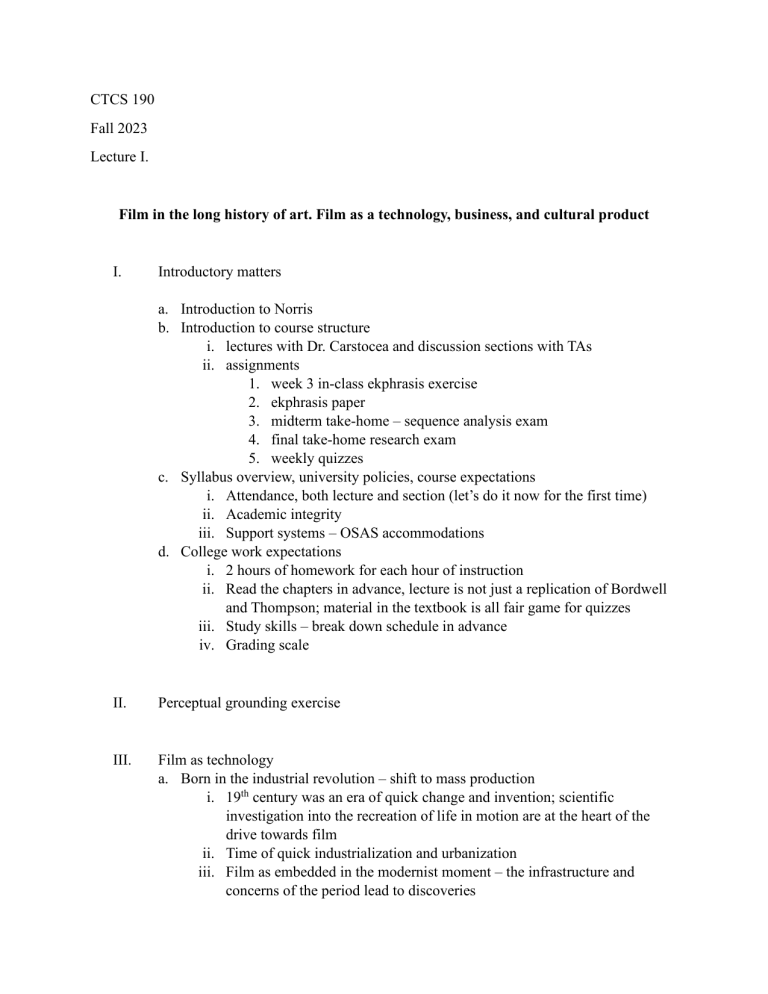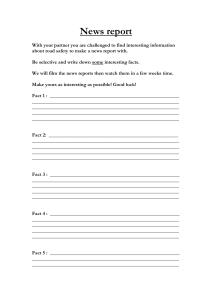Film History & Technology: Lecture Notes | CTCS 190
advertisement

CTCS 190 Fall 2023 Lecture I. Film in the long history of art. Film as a technology, business, and cultural product I. Introductory matters a. Introduction to Norris b. Introduction to course structure i. lectures with Dr. Carstocea and discussion sections with TAs ii. assignments 1. week 3 in-class ekphrasis exercise 2. ekphrasis paper 3. midterm take-home – sequence analysis exam 4. final take-home research exam 5. weekly quizzes c. Syllabus overview, university policies, course expectations i. Attendance, both lecture and section (let’s do it now for the first time) ii. Academic integrity iii. Support systems – OSAS accommodations d. College work expectations i. 2 hours of homework for each hour of instruction ii. Read the chapters in advance, lecture is not just a replication of Bordwell and Thompson; material in the textbook is all fair game for quizzes iii. Study skills – break down schedule in advance iv. Grading scale II. Perceptual grounding exercise III. Film as technology a. Born in the industrial revolution – shift to mass production i. 19th century was an era of quick change and invention; scientific investigation into the recreation of life in motion are at the heart of the drive towards film ii. Time of quick industrialization and urbanization iii. Film as embedded in the modernist moment – the infrastructure and concerns of the period lead to discoveries b. Six steps to film i. Still Photography 1. Camera Obscura first described in 5th century BCE by Mozi, founder of Mohism (China). His discovery was not picked up again until the Middle Ages: the camera obscura started being used by 11th century BCE – projecting real-life scenes on an interior surface; used as drawing aid in the 17th century, also gave birth to the first projection device for still images – the lanterna magica, or magic lantern 2. Finding a photosensitive substrate to record the image – Nicephore Nièpce, 1827 first photograph (heliograph on pewter, substrate was bitumen in oil of lavender). Exposed inside a camera obscura, exposure lasted hours, if not days (likely was several days for the first one) 3. Practical photography (exposure times reduced down to 15 minutes) developed from Nièpce’s approach by his employer/business partner Louis-Jacques-Mandé Daguerre – hence “daguerreotype” ii. Persistence of Vision 1. The human mind holds an image for a fraction of a second after you see an image – creates the illusion of motion 2. Phi phenomenon – our brain obtains the illusion of motion from serial imagery if presented at high enough frequency 3. Early to mid 19th century toys used these phenomena 4. Thaumatrope – Dr. John Ayrton Paris, spinning coin that makes the bird appear in the cage from the other side. Thauma=wonder; trope=turn; thaumatrope=to turn out wonder a. In lecture – example from Sleepy Hollow (Tim Burton, 1999) 5. Phenakistoscope – Joseph Plateau, 1832 6. Zoetrope – William George Horner, 1834 iii. Motion Picture Camera 1. Series Photography a. Eadweard Muybridge - Experiments commissioned by governor Leland Stanford of California to settle a bet about whether horses ever lifted all four feet/hooves off the ground at once. Muybridge arranged 24 cameras on strings set off by the horses as they ran by. You could see movement, but it was prohibitively expensive, and not much action was covered. b. Jules-Etienne Marey created a photographic gun which make 12 pictures on rotating glass plates. iv. Film Stock 1. Celluloid – cheap, easy, long intervals of action 2. Stock to take 1000s of stills 3. Invented by Hannibal Goodwin, refined by Eastman, produced by Edison/Lumiere/Pathe/etc. 4. Several framerates originally used, 24fps became standard with the arrival of sound v. The Printer 1. Converted negative images into positive images vi. The Motion Picture Projector 1. Methodically project in front of a powerful light 2. Lumière Brothers – December 28, 1895 – first public exhibition of motion pictures in Paris Clip: The Sprinkler Sprinkled (Lumière, France, 1895) Clip: The Arrival of a Train at La Ciotat (Lumière, France, 1896) c. Technology’s influence on production, aesthetics, business, and spectatorship. i. Technology influences aesthetics and business; all four areas influence each other i.e. the coming of sound allowed for musicals, development of box office ii. The Power of Film Technology 1. You’ll see what you missed 2. It allows us to see more; we edit reality. 3. It can maximize objects/sounds/silence; recreate the past and the future iii. Technology and expressive constraint IV. Film as business a. Production, distribution, exhibition i. Producers – Financial role, hiring labor ii. Distributors – Get the movies to theaters iii. Exhibitors – show the films b. originally exhibited in vaudeville, the most popular commercial entertainment i. At the end of the act as people getting up for intermission often skipped the last show. However, everyone stayed for the movie and it soon became the main attraction. ii. Fitted into the proscenium arch, hence the rectangular shape iii. Began running at their own venues (rickety) iv. 1905 – first Nickelodeon in Pittsburgh; 1st permanent home for motion picture; 15 minute programs v. 1914 – first movie palace (and first feature length); brought together upper and middle classes; built like a European opera house c. Early cinema – “Cinema of Attraction” per Tom Gunning – early kinetoscope shorts as well as early theatrical programs Clips: Zach King, Graffiti trick film, 2019; @jilliansurfs, TikTok trick edit, 2020 i. Every town had 6-8 theaters; the star system took off d. Modes of Production i. Large-scale production ii. Small-scale and independent production e. Distribution and exhibition i. Theatrical ii. Non-theatrical iii. Home video and streaming f. Organized labor and entertainment i. Current WGA and SAG-AFTRA strikes 1. Intellectual property rights and AI 2. Residuals and streaming 3. Labor protections and industrial churn g. Artistic implications of business context Influence of Business on technology and entertainment/art a. Post-WWII business practices and necessities i. TV and other leisure activities stealing audience; move to suburbs ii. New technologies as a response – widescreen, color introduced to bring back audiences iii. New aesthetics –genres such as the historical spectacle flourish V. Film in culture a. Urban context b. Affordability c. Socialization Clip: D.W. Griffith, Those Awful Hats (1909) d. e. f. g. Accessibility Cleanness Narrative Community h. Relatability i. Processes of taste formation j. The Social Dimension i. Filmmakers are subject to their social environment; film uses elements from society ii. Film is both from and about society and culture k. Cultural Dimension i. Film can reflect, subvert, idealize, or transform culture ii. We can encounter a past culture’s representations of themselves. VI. Film and art a. Placing film in the long history of art b. Paradoxes – artistic discourses and artistic inclinations might come at odds with technological limitations or business practices/decisions i. Film is collaborative, though art is seen as the product of individual personality. ii. Technology is impersonal, while art is seen as personal iii. Film is a business; the medium is dictated by economics iv. Film is for a mass audience, appeals to the lowest common denominator, while art has to challenge and transcend time c. Film contains the seven traditional art forms i. literature - plot, character, pov ii. theater – structure, performance iii. painting – spatial composition, light iv. dance – movement, related to sound v. architecture – creates and shapes space vi. sculpture – three dimensional objects you can move around vii. music – rhythm, pace, harmony, motif d. Film is a technology with industrial, cultural, and artistic aspects e. Influence of entertainment/art upon technology and business i. Aesthetics affects technology which affects business ii. i.e. In order to create his vision of Star Wars, Lucas had to advance technology, which in turn changed the business VII. VIII. f. Creative decisions – mise en scene, cinematography, editing, sound i. Examples from Perceval le Gallois, Barry Lyndon, and Shadow 15 minute break Intro to Cave of Forgotten Dreams a. Werner Herzog b. Documentary and expressiveness c. Documentary and reality d. From cave paintings to 3D cinema



